![]()
![]()
![]()
Use LEFT and RIGHT arrow keys to navigate between flashcards;
Use UP and DOWN arrow keys to flip the card;
H to show hint;
A reads text to speech;
46 Cards in this Set
- Front
- Back
|
transmembrane transport |
transport between two compartmentsmediated by a protein orprotein complex called a translocator |
|
|
protein transport into mitochondria |
General Features: mediated by transmembranetranslocators mostly uni-directional transport import signal sequence required at theN-terminus of an imported protein signal sequence cleaved once it isimported into the matrix post-translational import mechanism imported as unfolded protein Molecular chaperones involved (chaperones are proteins assisting in thefolding or unfolding of other proteins) |
|
|
Major and minor systems to generate michondrial proteins |
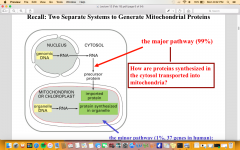
|
|
|
transport machinery for cytosol to mitochondrial transport |
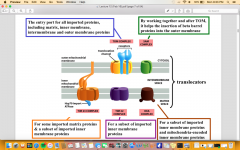
|
|
|
TOM complex |
The entry port for all imported proteins,including matrix, inner membrane,intermembrane and outer membrane proteins |
|
|
SAM complex |
By working together and after TOM,it helps the insertion of beta barrelproteins into the outer membrane |
|
|
TIM 23 complex |
For some imported matrix proteins& a subset of imported innermembrane proteins |
|
|
TIM 22 complex |
For a subset of importedinner membraneproteins |
|
|
OXA complex |
For a subset of importedinner membrane proteinsand mitochondria-encodedinner membrane proteins |
|
|
Where do most mitochondrial proteins go after they leave the cytosol? |
the matrix |
|
|
Overview of cytosol to mitochondrial matrix transport |
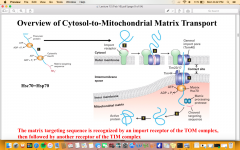
The matrix targeting sequence is recognized by an import receptor of the TOM complex,then followed by another receptor of the TIM complex Proteins are imported in a post-translational but unfolded state. Transport occurs via the contact sites between outer and inner membranes. Chaperones are required on both cytosolic and matrix sides. ATP is required on both cytosolic and matrix sides. H+ gradient across the inner membrane is also required. |
|
|
Features of matrix targeting sequence |
amphipathic alpha-helix (20-50 a.a. long) but no specific a.a. sequence.located at the N-termini of imported proteins a.a. composition of one targeting sequence:positive residues every 3 or 4 a.a.hydrophobic residues about every 3 or 4 a.a. the secondary structure of targeting sequencespositive a.a. residues (in red) on one sidehydrophobic residues (in yellow) on the other side |
|
|
Structure of the Complex between a Matrix-Targeting Sequence ofAlcohol Dehydrogenase and the Import Receptor |
The hydrophobic side of the amphiphilic alpha helix binds to a hydrophobic groove of the import receptor (another example of the general principle: hydrophobic likes hydrophobic) |
|
|
How do we know that import into the mitochondria can occurpost-translationally in an unfolded state? |
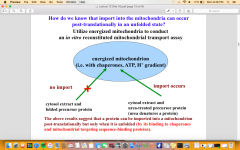
Utilize energized mitochondria to conduct an in vitro reconstituted mitochondrial transport assay The above results suggest that a protein can be imported into a mitochondrionpost-translationally but only when it is unfolded (by its binding to chaperonesand mitochondrial targeting sequence-binding proteins). |
|
|
Energy and Chaperone RequirementDuring Cytosol-to-Matrix Transport |
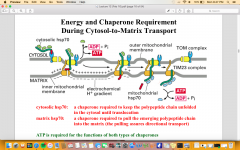
cytosolic hsp70: a chaperone required to keep the polypeptide chain unfoldedin the cytosol until translocation matrix hsp70: a chaperone required to pull the emerging polypeptide chaininto the matrix (the pulling assures directional transport) ATP is required for the functions of both types of chaperones H+ gradient is required at an intermediate step, probably the translocation of thematrix targeting sequence across the inner membrane. |
|
|
Chaperones in Cytosol-to-outer membrane Transport |
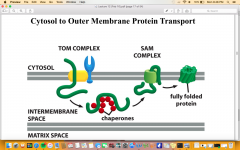
|
|
|
Cytosol to Inner membrane protein transport |
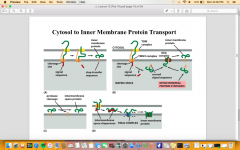
|
|
|
cytosolic hsp70 |
a chaperone required to keep the polypeptide chain unfoldedin the cytosol until translocation |
|
|
matrix hsp70 |
a chaperone required to pull the emerging polypeptide chaininto the matrix (the pulling assures directional transport) |
|
|
H+ in cytosol to matrix transport |
H+ gradient is required at an intermediate step, probably the translocation of thematrix targeting sequence across the inner membrane. |
|
|
Cytosol to peroxisome transport |
general features: translocator-mediated signal sequence required(found in the C-terminus) mostly uni-directional transport post-translational mechanism imported as foldedpolypeptide chains |
|
|
basic structure of peroxisomes |
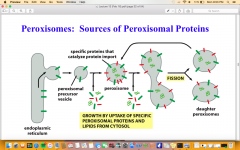
one membrane, enzymes involved in oxidation, sources of peroxisomal proteins |
|
|
Signal Sequences for Peroxisome Import |
A group of more than 20 proteins (peroxins) constitute the transport machinery. Less is known regarding this transport mechanism. In vitro transport assays suggest that the cargo can be transported in its foldedstate. If so, how a cell maintains peroxisome integrity during protein importis a challenging research question. The prevention of component mixing between peroxisome and cytosolduring intracellular protein transport is mysterious but an important consideration. |
|
|
Cytosol to ER transport |
General Features:
Translocator-mediated ER signal sequence required(often cleaved after translocation) bi-directional transport (although itseems uni-directional from the diagram)(e.g. misfolded proteins, pathogens) usually co-translational importimported as unfolded polypeptide chains |
|
|
Two Types of ER Membrane Domains |
rough: polyribosomes attached the biosynthesis of proteins smooth: no ribosomes attached the biosynthesis of lipids & steroids regulation of Ca2+ |
|
|
ER signal vs different types of transport signals of intracellular transport |
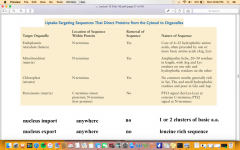
|
|
|
How do we know ER translocation occurs co-translationally? |
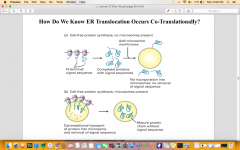
|
|
|
Overview of cytosol-to-ER transport diagram |
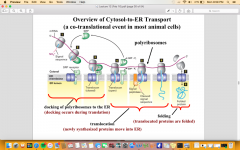
1. docking of polyribosomes to the ER (occurs during translation) 2. Translocation (newly synthesized proteins move into ER) 3. Folding (translocated proteins are folded) |
|
|
Docking of polyribosomes to the ER |
Co-translational docking of polyribosomes to the rough ERrequires: the ER signal sequence (on a cargo) SRP (in the cytosol) SRP receptor (on the rough ER membrane) |
|
|
ER signal sequence |
a short stretch of hydrophobic residues (usually 6-12 a.a. long) locatedat the N-terminus of a cargo protein targeted to the ER |
|
|
SRP |
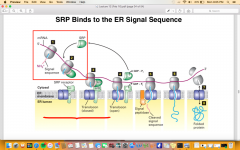
a complex (containing both RNAs and proteins) recognizing the ERsignal sequences of a cargo protein Due to its N-terminal location, the signal peptide is recognized by SRP soon afterits synthesis (before translation is completed). GTPase |
|
|
SRP receptor |
an ER integral membrane protein composed of two subunits, α & β.It recognizes SRP. GTPase |
|
|
SRP bound to ER signal sequence |
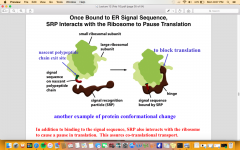
Once bound, SRP Interacts with the Ribosome to Pause Translation EX of protein conformational change In addition to binding to the signal sequence, SRP also interacts with the ribosometo cause a pause in translation. This assures co-translational transport. |
|
|
Interaction of SRP & SRP receptor |
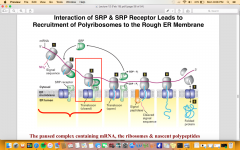
Leads to Recruitment of Polyribosomes to the Rough ER Membrane The paused complex containing mRNA, the ribosomes & nascent polypeptidesis recruited to the rough ER membrane by the SRP-SRP receptor interaction. |
|
|
Proofreading function of SRP & SRP receptor |
Proof-Read ER Signal Sequences Translation will not resume until SRP leaves the polyribosome complex,which is controlled by GTP hydrolysis A bad signal sequence will dissociate with the SRP before the hydrolysis of GTP.Thus, SRP/SRP receptor function as a molecular clock to allow sufficient time to check the quality of the signal sequences. |
|
|
Translocon |
SRP/Signal Sequence Communicate with the Translocon to Initiate Translocation If the signal sequence is good, the mRNA-ribosome-nascent polypeptide chain complex istransferred from the SRP/SRP receptor to the translocon and the GTP hydrolysis ofSRP/SRP receptor occurs. As a result, translation resumes. Moreover, the signal sequenceopens up the translocon and functions as a signal to start the translocation |
|
|
Multiple functions of the SRP |
interacts with the signal sequence (to recruit the polyribosomes to the ER) interacts with the ribosome (to pause translation and ensure co-translational translocation) interacts with the SRP receptor (to dock polyribosomes to the ER)(to proof-read the signal sequence) communicates with the translocon (to initiate the translocation process) Explains Why Its Structure isComplex, Compared to Other Types of Signal Receptors is a ribonucleoprotein particle (containing RNA and protein) |
|
|
Translocation |
Translocation of the nascent polypeptide chain by an open translocon After attaching to the ER membrane, the ribosomes and nascent chains aretransferred to the translocon. As translation resumes, the elongating chainpasses directly from the large ribosomal subunit to the central pore of thetranslocon. |
|
|
Conformational changes between the closed and open states of Sec61 translocon |
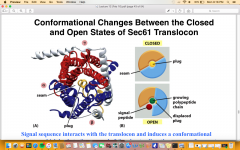
Signal sequence interacts with the translocon and induces a conformationalchange, which leads to the removal of the plug to allow the passage of nascentpolypeptide chain into the lumen.The pore can probably open to the lateral side as well to allow the signalsequence and the transmembrane domains to be released to the lipid bilayer where they can be subsequently cleaved or inserted. |
|
|
How is the permeability barrier maintained while the translocon is open? |
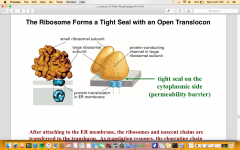
The ribosome forms a tight seal with an open translocon After attaching to the ER membrane, the ribosomes and nascent chains aretransferred to the translocon. As translation resumes, the elongating chainpasses directly from the large ribosomal subunit to the central pore of thetranslocon (without being exposed to the cytoplasm). |
|
|
Evidence for a tight seal on the cytoplasmic side but not on the lumenal side |
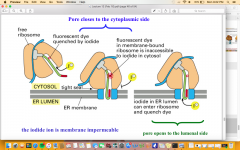
|
|
|
gating model of the Sec61 translocon |
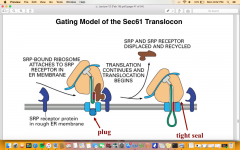
|
|
|
ER signal sequence and translocation |
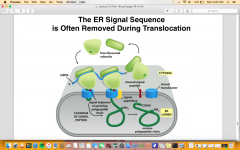
often removed The signal peptidase closely associates with the translocon and clips off the signal sequence at the lumenal side of the membrane |
|
|
folding of the translocated nascent polypeptide chain |
Chaperones are needed in ER lumen to facilitate the folding of a nascent protein.However, no chaperones are needed in the cytoplasmic side during translocation. |
|
|
Why are chaperones only needed in the lumenal side during co-translational ER translocation? |
during co-translational translocation, the length of nascent protein chain is short on the cytoplasmic side during translocation. As aresult, the protein cannot fold before being pushed into the lumenand therefore there is no need of chaperones to unfold the protein. |
|
|
A Common Theme BetweenCo-Translational ER Transport in Eukaryotes andCo-Translational Transport Across the Cell Membraneof Bacteria and Archaea |

|

